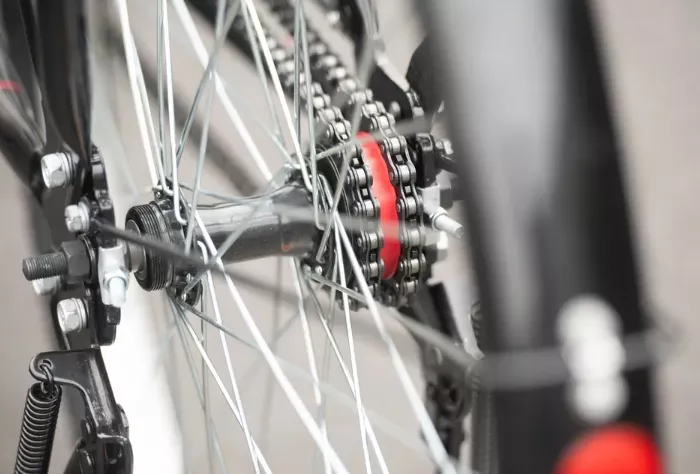The Buffalo Utility S2 bike, developed by the non-profit World Bicycle Relief (WBR), is reshaping the way people move goods across challenging terrains. With a focus on simplicity and durability, this bicycle features an innovative two-chain drivetrain, which sets it apart from traditional models.
Jackton Achola, a bread delivery driver in Kisumu, Kenya, is among the first to test this new design. Each day, Achola loads his Buffalo bike with colorful pallets of bread, enough to serve around 480 people, and secures the load with rubber cables. For years, he has relied on the single-speed Buffalo bike to navigate his community, but now, thanks to the new two-chain system, his deliveries have become more efficient.
Achola is one of eight testers in Kenya trialing WBR’s latest Buffalo model, equipped with the new AK2 drivetrain system. The system, which features two chains instead of one, was developed over two years and has been patented with the support of US parts manufacturer SRAM. The concept was born from feedback from riders like Achola, who expressed the need for additional gears when riding with heavy loads.
A Revolution in Design and Durability
Michael Kelly, WBR’s program director, explains that the idea for the two-chain system came after many riders using the previous single-speed model found it difficult to manage heavy cargo without the option for a gear shift. “One of the pieces of feedback was the desire to add a gear to the bike when you’re riding under a heavy load,” says Kelly. “That was sort of the dream behind it.”
The two-chain drivetrain is featured in the latest iteration of the Buffalo bike, the Utility S2 model, which launched in July. Since then, the bike has been rigorously tested, covering thousands of miles, and it has earned accolades at bike design shows. Now, it is being distributed across WBR’s project locations in sub-Saharan Africa and South America.
Designed for Harsh Environments
WBR operates in regions where rugged terrain, extreme heat, and heavy cargo are everyday challenges. Kelly explains that the Buffalo bike was designed to endure these harsh conditions. “You can’t have external derailleurs that are going to get gunked up or damaged, and then not have the ability to service those when you’re in these remote environments,” he says. Traditional derailleur systems often fail under such conditions, but the two-chain system avoids this problem by eliminating complex mechanisms that might break down in the field.
The two-chain system itself works through an innovative mechanism engineered by SRAM engineers. “You have two different chain rings at varying tensions,” explains Kelly. “Through a backpedal shifting motion, the freewheel shifts from one chain tension to the other, allowing you to change gears without adding complicated derailleur systems.”
This ingenuity allows WBR to offer a bike that’s both functional and durable without the need for external wiring or complicated parts. The simplicity of the design ensures that trained mechanics, available in the communities where WBR operates, can repair the bikes easily.
Expanding Access and Impact
The Buffalo bike is assembled in Taiwan at the Giant factory before being shipped to WBR’s program countries: Kenya, Uganda, Zambia, Malawi, Tanzania, Zimbabwe, and Colombia. The full cost of producing and delivering one bike, from material extraction to the point it reaches its owner, is about £145 ($180). While individuals can purchase the bike, those in the program receive it for free.
WBR’s broader mission focuses on creating sustainable bicycle ecosystems within these communities. “We’ve trained over 3,500 mechanics across our program countries, and there are more than 100 Buffalo bike retail shops in operation,” says Kelly. This infrastructure ensures that bicycles remain in service for years to come.
The response to the new model has been overwhelmingly positive. “The feedback so far from our test riders and the people that are getting access to this bike is that they love the extra gear,” Kelly reports. For riders like Achola, the extra gear has made a significant difference, making it easier to tackle the heavy loads he transports daily.
A Workhorse Built for the Long Haul
Despite weighing 23kg—more than three times the UCI minimum weight limit for competitive racing bikes—the Buffalo bike is designed for rugged utility rather than performance. Its steel frame and aluminum rims are built to endure, and the addition of a kickstand makes loading and unloading easier.
In the communities where WBR operates, the new Buffalo model has proven to be a “game changer,” says Kelly. “It’s a tried and tested, robust workhorse that’s been designed to work in these environments.”
With over 850,000 bikes distributed and the milestone of 1 million bikes within reach, WBR is excited to continue its work, empowering more individuals like Achola. These bikes are more than just a means of transportation—they are a lifeline to better mobility, faster deliveries, and greater opportunities.
As Achola reflects on his experience with the new bike, he shares his hope for its broader impact: “I really would like this bicycle to improve the whole world.” With each backpedal, this revolutionary bike is doing just that.
Related topics
- Patrick Lefevere’s Cycling Legacy
- Joe Blackmore Reflects on 2024 Success and Future Ambitions
- The Joy of Cycling-Themed Christmas Gifts

